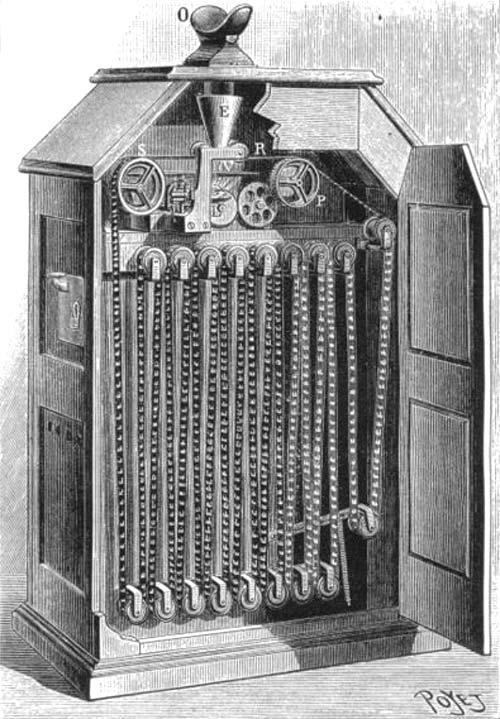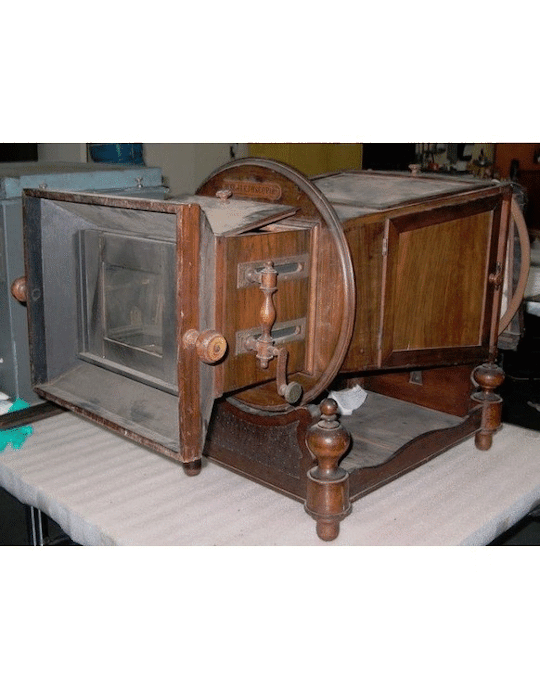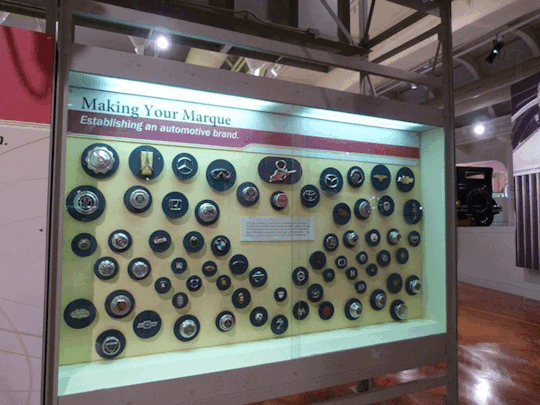#megalethoscope
Text
Screenology Post 2: Brody Feigin
The idea of peering into a hole was evoked again and again along the cultural trajectory leading from the 18th century peepshows to 19th century devices like the Megalethoscope, the stereoscope and the zoetrope and further to early moving picture viewers such as the Mutoscope and the Kinora. The domestic devices accompanied the popularity of public entertainments from old style touring peepshows to new forms like the cosmorama, the Kaiser Panorama and eventually the Kinetoscope and the Mutoscope.

0 notes
Photo


This megalethoscope slide shows Naples and Mount Vesuvius. Megalethoscopes were late 19th century devices that allowed viewers to look through a lens at various photographic scenes in a couple of different ways. One way was to view the photograph as it appears lit from the front (day view), and the other was to view an enhanced backlit version (night view), which was created utilizing a method that included painting and piercing the back of the print so that when lit from behind it added to the illusion of color and depth.
#Vesuvius Day#mount vesuvius#megalethoscope#19th century#19th century photography#Italy#Volcano#Volcanoes#VesuviusDay#Pompeii
36 notes
·
View notes
Photo

MEGALETOSCOPIO, en 1859 se inventa este proyector que permite ver fotos blanco y negro de día y a su misma vez en noche en colores, fue diseñado por Carlo Ponti también permite ver la profundidad y perspectiva de la imagen. Instagram @fotografos_master #carloponti #megaletoscopio #megalethoscope #1859 #oldproyector #proyector #photoviewer #filmprojector #photoprojection #photohistory #filmhistory #cinemateatrehistory #filmprojectionhistory #filmschool #photoschool #facts #factsofphotography #photographyfacts #camera #filmcamera (at Italy) https://www.instagram.com/p/CE_G9PmDTHJ/?igshid=1402jecmt8plv
#carloponti#megaletoscopio#megalethoscope#1859#oldproyector#proyector#photoviewer#filmprojector#photoprojection#photohistory#filmhistory#cinemateatrehistory#filmprojectionhistory#filmschool#photoschool#facts#factsofphotography#photographyfacts#camera#filmcamera
0 notes
Photo

Advertisement for a Megalethoscope, Invented by Charles Ponti, 1862–65, Smithsonian: Cooper Hewitt, Smithsonian Design Museum
Size: 26.5 x 37.8 cm (10 7/16 x 14 7/8 in.)
Medium: Photostat on white paper
https://collection.cooperhewitt.org/view/objects/asitem/id/132436
6 notes
·
View notes
Photo



Another model of the megalethoscope, an optical device invented in the early 1860s by Carlo Ponti, optician to King Victor Emanuel II of Italy. It is used to view specially prepared prints and photographs through a large lens which creates the illusion of depth and perspective. The photographs are either backlit by an internal light source (such as an oil lamp) or lit by daylight. This light could be used to create various visual effects that worked with the prints, which were prepared so that certain sections of the paper were thinner than others.
63 notes
·
View notes
Text
When Conservation Met Digitization
For the entire month of November, we at The Henry Ford are celebrating the digitization of over 100,000 artifacts! To reach a goal of 100K artifacts digitized takes many people and departments coordinating and working together. Let’s look at how our conservation department contributed to this momentous achievement. I’ll be highlighting one of the current projects in which digitization is a crucial step.

This graphic shows the various steps in The Henry Ford's digitization process, and where conservation fits in.
As Project Conservator on a three-year Institute of Museum and Library Services (IMLS) grant awarded to The Henry Ford, I work with other conservation and collections specialists to clean and stabilize 3D objects from our Collections Storage Building. These objects oftentimes have never been on display, let alone photographed. As conservators, it’s our responsibility to make sure the objects are not only camera-ready but are structurally sound for exhibition or museum storage.

For this IMLS grant, the objects undergo a multi-step process involving many hands in order to get to digitization. First, objects are tagged by collections or conservation staff with a Tyvek label that states the object number (if known), description/identifying name, and location found in storage. This tag stays with the object throughout the various stages and is updated with staff initials as tasks are completed.

Objects are then vacuumed to remove surface dirt and/or mold before moving from the storage building to be cleaned thoroughly in the Conservation Lab. If the object is too large to handle, it stays in the building for conservation treatment performed in a section that has been zoned off as a clean room. Outside contractors bring in heavy-duty equipment to lift and move the bigger and heavier objects.

A Herschell-Spellman steam engine (27.139.1) rigged up for moving out of storage.

Caravan of large objects being moved out of storage!
If the object is an appropriate size for the IMLS team to handle and move by forklift or box truck, we bring it back to the Conservation Lab for cleaning and stabilization.

Due to the number of objects we conserve, not all get photographed in the lab. That will happen later! However, we do take before, during, and after conservation treatment photos for some objects that have interesting conservation treatments and/or a significant change from start to finish.

Check out a recent blog on the conservation treatment of this Megalethoscope (32.742.113).
Other staff are also involved in the IMLS grant, including registrars who catalog and attach a unique accession number to each object.

Quick photographs are often taken at this stage in order to research and find more information about the object.

Finally, the object is ready for its close-up! It moves down to our photography studio to be photographed under the proper lighting and with a professional grey backdrop. Sometimes the object is so large that is easier to photograph it in its new storage location. You can find all of these images in our Digital Collections on THF.org.

Here is a Pratt & Whitney Gear Cutter and Lathe, circa 1900, getting set up for photography in storage.

Click here to visit our Digital Collections and search for digitized artifacts!
As we are all facing challenges this year brought on by the COVID-19 pandemic, we have had to adopt new procedures to keep the process running smoothly! It has not been possible to photograph all objects included in the grant. Before the object leaves the conservation lab and moves to storage, though, it gets quickly photographed, and that image is attached to the record in our collections database.

At a later date, our photographer will take the beauty shot for Digital Collections and keep the tally rolling on our digitization numbers! As of today, over 3,500 objects have been pulled from storage, conserved, and rehoused during this three-year grant. Close to 3,000 of those objects have been digitized and are available online.

Photographer Rudy Ruzicska taking the perfect image.
The final step for these objects is moving to a new home in storage, going on loan, or display for THF visitors to see up close. We work with collections management staff to box, palletize, and wrap the objects before finding the perfect location in storage or sending them on their next adventure for public viewing. The objects from this IMLS grant are just a small portion of the 100,000 artifacts that have been digitized, but they also include some of the largest objects we have in the collection!

A couple of generators sitting in front of boxed and palletized objects in storage.
Let’s end with a blast from the past of The Henry Ford’s early digitization days in 2012. Here are a few images of what it took to digitize an abundance of hubcaps! Some of these you may have seen on display in the Driving America exhibit. The rest you can find in Digital Collections.

For an in depth look at hubcaps, check out this blog post.
Congratulations to all who have helped over the years to get so many of The Henry Ford’s artifacts digitized and accessible!
The Henry Ford is facing unprecedented financial challenges due to the impact of our 16-week closure and reduced operations. We need your help in securing our future. Love the Henry Ford? Please support all that we treasure—including our digitization program. Longtime supporters of The Henry Ford will match your donation dollar for dollar, so your contribution will have double the impact.
Marlene Gray is IMLS Project Conservator at The Henry Ford.
#1 Ford Daily | Đại lý – Showroom ủy quyền Ford Việt Nam 2019 Ford Daily là showroom, đại lý Ford lớn nhất Việt Nam: Chuyên phân phối xe ô tô FORD như: EcoSport ✅ Everest ✅ Explorer ✅ Focus ✅ Ranger… [email protected] 6A Đường Trần Hưng Đạo, Phường Phạm Ngũ Lão, Quận 1, Hồ Chí Minh 711240 0901333373 https://forddaily.com/ https://forddaily.com/xe/ https://forddaily.com/dai-ly/ https://forddaily.com/bang-gia/ https://forddaily.com/tra-gop/ #forddaily #dailyfordhcm #fordshowroomhcm https://www.google.com/maps/place/Ford+Daily/@10.7693359,106.696211,15z/data=!4m5!3m4!1s0x0:0x1f188a05d927f4ff!8m2!3d10.7693359!4d106.696211
0 notes
Photo



Site Seeing - Cinematic Device
Pre-Cinematic and Cinematic Devices
Precursors of film are concepts and devices that have much in common with the later art and techniques of cinema.
Thaumatrope (Image One)
The Thaumatrope was one of the first devices invented to create 2D animation. It works by quickly flickering two images on either side of a circular piece of card/paper, with wound strings attached adjacent on either side, and quickly pulling to unwind the strings and spin the images in a flip-book style. This is a quick two image animation that delivers a recurring animation. It provides an illusion of motion that is further explored with the Phenakistiscope which was later invented with a wider range of images and a spinning effect. The name translates roughly as "wonder turner", from Ancient Greek.
Megalethoscope (Image Two)
The Megalethoscope is an optical apparatus designed by Carlo Ponti of Venice before 1862. Photographs are viewed through like a view-finder or lens, which creates an optical illusion of depth and perspective within the image. The photos were either back-lit by an internal light source (an oil or kerosene lantern) - or lit by daylight through a system of opening doors. The photographs were transparent and usually colored to create dramatic visual effects when viewed.
Instant Camera (Image Three)
The instant camera uses self developing film that chemically develops in a short period of time to reveal a taken image. They often appear as images with a sepia tone, and a strong contrast of light and dark. The earliest instant camera, which consisted of a camera and portable wet darkroom in a single compartment, was invented in 1923 by Samuel Shlafrock. They are commonly known now as Polaroids which quickly became the most popular version of the instant camera.
https://en.wikipedia.org/wiki/Instant_camera
https://slideplayer.com/slide/1480893/
https://twitter.com/CantorArts/status/644194924494221312/photo/1
0 notes
Text
Pre-Digital Humanities
Checking out Spooner’s protean views and other ‘hold-to-light’ prints
Another way to appreciate protean views is by using a Polyorama Panoptique, popular from the 1820s through to the 1850s (and today). The portable, collapsible viewer was invented by Pierre Seguin, often given away as a souvenir during popular events or exhibitions. It is a miniature version of the megalethoscope.
John…
View On WordPress
0 notes
Photo



The Megalethoscope created dramatic perspective and lighting effects when used to view specially prepared photographs. With this instrument, its inventor tells us, “pictures are considerably magnified, whilst they stand out in bolder relief without exaggeration.”
Carlo Ponti. The megalethoscope, invented by Charles Ponti, optician & photographer. : Its object and use. ca 1862. New-York Historical Society.
19 notes
·
View notes
Photo

~Megalethoscope.
Artist/Maker: Carlo Ponti (Italian, born Switzerland, about 1823 - 1893)
Culture: Italian
Place: Italy (Place created)
Date: about 1862
Medium: Wood, metal fixtures, and glass
An optical viewing device for photographs which enlarges and adds apparent dimensionality to them. The photographs are applied to specially designed concave plates which are inserted into the viewer.
15 notes
·
View notes
Video
instagram
Megalethoscope
0 notes
Photo

ca. 1870, [Megalethoscope]
via Cowan's Auctions
11 notes
·
View notes
Text
Optical devices on view
Optical devices on view
Our new reading room includes a consultation room at one end for small classes and group discussions. The room also includes a case now filled with a portion of the optical devices collection. These include a portable camera obscura, camera lucida, stereoviewers, megalethoscope, zograscope, zoetrope, thaumatropes, magic lanterns, and much more. You are welcome to come individually or with a group…
View On WordPress
0 notes